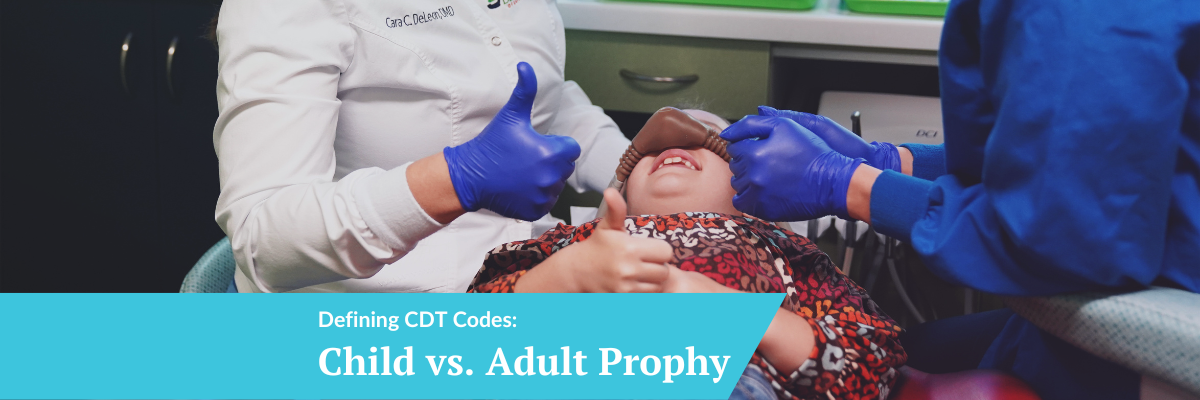Defining CDT Codes: Child vs. adult prophy (D1120 vs. D1110)


CDT coding is a difficult but necessary area of knowledge that every dental professional needs to be familiar with. But it can be challenging to use each CDT code correctly, especially when they are similar in name, numeric code, and description.
But it’s knowledge worth having to file claims accurately, to receive payers’ reimbursements promptly and consistently, and to avoid accusations of fraud due to downcoding or upcoding.
Dentistry IQ explains why both you and your staff should be proficient with CDT codes:
“As health-care professionals, we have an obligation to ensure that the proper codes are reported for the procedures we render. This is a requirement for accuracy of records. As license holders, it is also in our best interest to have an understanding of the codes that fall under our scope of practice.
There needs to be an understanding by both the business and clinical staff, along with a symbiotic working relationship that promotes better communication, accuracy, and efficiency across these equally important departments.”
Our pool of experts — aka The DCS Knowledge Network — has a thorough understanding of niche dental industry topics such as CDT Coding. Our in-house network helps dental teams stay informed about changes and updates to codes.
And today we’re clarifying the difference between Child Prophy vs. Adult prophy (D1120 vs. D1110), which are especially easy to confuse.
Let’s start with their basic descriptions…
CDT Code: D1120 prophylaxis – Child
Removal of plaque, calculus, and stains from the tooth structures in the primary and transitional dentition. It is intended to control local irritational factors
CDT Code: D1110 prophylaxis – Adult
Removal of plaque, calculus, and stains from the tooth structures in the permanent and transitional dentition. It is intended to control local irritational factors.
You might have just read those descriptions and thought: How the heck are those different?
Just one word makes all the difference. Let us explain:
When you look closely at descriptors for D1120 and D1110, you’ll see the patient’s current dentition is what distinguishes a child from an adult, and not their age.
Code D1120 would accurately report a prophy performed on a patient with all primary dentition or with primary and permanent dentition.
Code D1110 would accurately report a prophy performed on a patient with all permanent dentition.
For example, here is a scenario that highlights where choosing the appropriate code can be a little tricky…
Either code D1120 or D1110 may report a prophy performed on a patient with transitional dentition, that is, a mix of primary and permanent dentition. For instance, a child with transitional dentition can be reported with D1110 — the Adult Prophy code.
What is not appropriate is reporting D1120 — the Child Prophy code — for a child with full permanent dentition, regardless of the age limitation of their dental plan. It is not unusual for an 11-year-old child to present with full and permanent, and thereby adult, dentition; therefore, D1110 prophylaxis – Adult would be the appropriate CDT code for this 11-year-old’s treatment.
Incorrect CDT Codes cost real money
CDT codes define the necessity of treatment for a patient, and are used by various entities in the dental industry for reporting and reimbursement.
The CDT code set meets HIPAA requirements for reporting dental services to other parties, including a patient's dental insurance plan. Insurance companies use CDT codes to determine which dental procedures are eligible for reimbursement under the patient’s plan.
Therefore, when a code is incorrect, the claim will be denied and its payment will be delayed. While your team can always appeal denied claims, the time spent resubmitting them plus moving them through the appeals process creates a dip in your business’ overall revenue.
This can be hard to believe, but it’s true: a single-digit coding error can cause 5-figure problems.
Incorrect codes can also result in fraud — even if it’s accidental fraud. We see this when dental teams upcode or downcode a claim, which is assigning a code that pays at a higher level than the performed service, and using a code for a lesser service than what was performed, respectively.
The codes your team uses affects the amount you are reimbursed by payers, and it’s considered fraud when you receive more than you are entitled to. Obviously, this can lead to legal issues for your dental practice, and it puts your reputation and your license at risk.
Moral of the story? Getting CDT codes correct is crucial to your continued success, both financially and professionally.
Read More: CDT Codes: Current Dental Terminology explained
Turn to the DCS Knowledge Network to code confidently
While CDT codes can be difficult to understand and annual changes are a challenge to keep up with, they’re both made easier when you partner with insurance billing experts.
Your dental practice shouldn’t lose money to something like CDT coding errors — and you shouldn’t lose your license or your patients to it, either.
When you partner with DCS, you will gain access to our DCS Knowledge Network. Your dental business will have one or two designated Account Specialists, and through them, you’ll truly have access to all their seasoned colleagues.
And if your Account Specialist ever faces confusion when handling your claims, they will turn to other experts in the DCS Knowledge Network, and find the answer.
If your dental team finds it difficult to juggle the claims process while prioritizing patient care, then our specialists help with your business’ revenue cycle will be a huge relief to them, and also a benefit to your patients.
Don’t lose money, time, and patients to coding errors and denied claims. Code confidently when DCS has your back: Talk to an RCM expert today.
Related Posts
Dental revenue resources from Dental Claim Support
.png)

